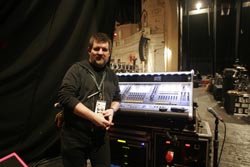Pogues' monitor engineer Dave Guerin.Undertaking their traditional pre-Christmas tour of the UK, folk/rock artists The Pogues had a present of their own as monitor engineer Dave Guerin took along the latest DiGiCo D5 console.
With the BBC's decision to censor the band's biggest hit 'Fairytale Of New York' - and then doing a smart U turn - doing nothing to diminish interest in the shows, the UK's longest established sound and lighting company, Entec Sound and Light, supplied the console along with a monitor system of Shure PSM600 in-ears, APW wedges and d&b C7 sidefills.
"Dave wanted the D5 and also insisted it was upgraded to the latest V4 software, because there are a lot of enhancements for monitors in the version," says Entec sound manager Dick Hayes. "So we took the opportunity to upgrade all our DiGiCo consoles at the same time."
Working with the band since the beginning of 2007, Guerin has been using DiGiCo consoles for the past four years. And with the latest revision bringing many improvements to the monitor side, he is pleased with the way that the company has responded.
"I talked to DiGiCo's software guys, who does the software at DiGiCo, about two years ago and explained how monitors are very different to front of house," says Guerin. "Monitor engineers have some very precise requirements and a lot of those ideas are in the latest revision, which is great.
"Most console manufacturers don't listen and, as a result, most desks are front of house desks. In contrast, the D5 has all these extra bits now for monitors, so it makes it a lot easier."
One of the main improvements is in how the graphic equalizer on each output has been made more immediately accessible. "Now you can easily see the graphic that is inserted on the selected output and it's immediately available," continues Guerin. "As soon as you select the output, the graphic's there. You're listening to the output, seeing the graphic and can get to it immediately. It's much more user friendly.
"You can also be listening to one output, but select a different mix to the one you are listening to, which means you can adjust the reverb send while listening to where the reverb is returning to. You couldn't do that before, you could only see the faders you were listening to at the time."
Although more sets were provided, only accordion player James Fearnley used in-ears on the tour, the rest of the band preferring the more 'traditional' approach of the wedges and sidefills.
With an eight-piece band, plus brass section, Guerin had a number of mixes to keep under control, all of which, of course, had to satisfy the different requirements of the musicians.
"Nobody really hears everybody else," he smiles. "Those on one side of the stage don't really hear anybody from the other side and vice versa. For example, Jem Finer's wedge mix just comprises his banjo and vocal, which is what he wants. He hears the rest of the stage from the ambient sound, the bass, whistle and drums tend to cut through naturally, but he doesn't really hear anybody else individually.
"On the other hand, Terry Woods has his mandolin, vocals, his cittern and the accordion is very loud in his mix. When it comes to monitors, all that matters with the sound is that it's high quality, it's the speed of how quick you can be with the desk that's the main thing. That's the beauty of a digital desk, you can do everything so much quicker.
"On Fairytale Of New York, Ella Finer sings the part originally sung by Kirsty MacColl. Guitarist James Walbourne has a full mix of drums, accordion, banjo, and main vocal, plus his vocal and acoustic. Ella uses the same wedges but with a totally different mix of just her vocal plus a bit of the main vocal. On the D5, with one fader I can change between the mix for James and the mix for Ella in the same set of wedges. On an analogue desk there would be lots of buttons having to be turned off. I also have plenty of channels if somebody wanted a different sound for an instrument, I could do it and not worry about it.
Effects-wise, Guerin was solely using the D5's internal effects. "I mostly use reverbs and graphics," he says. "There's reverb on Shane[MacGowan]'s vocal, reverb on the whistle and graphics on everything. It's another big advantage of using digital - if we had to do this with an analogue desk there would be loads of outboard graphics, five reverbs, ten compressors and God knows what else - plus another desk for the support band, whereas the support band's monitors are also done on this console."
DiGiCo...www.digico.org










